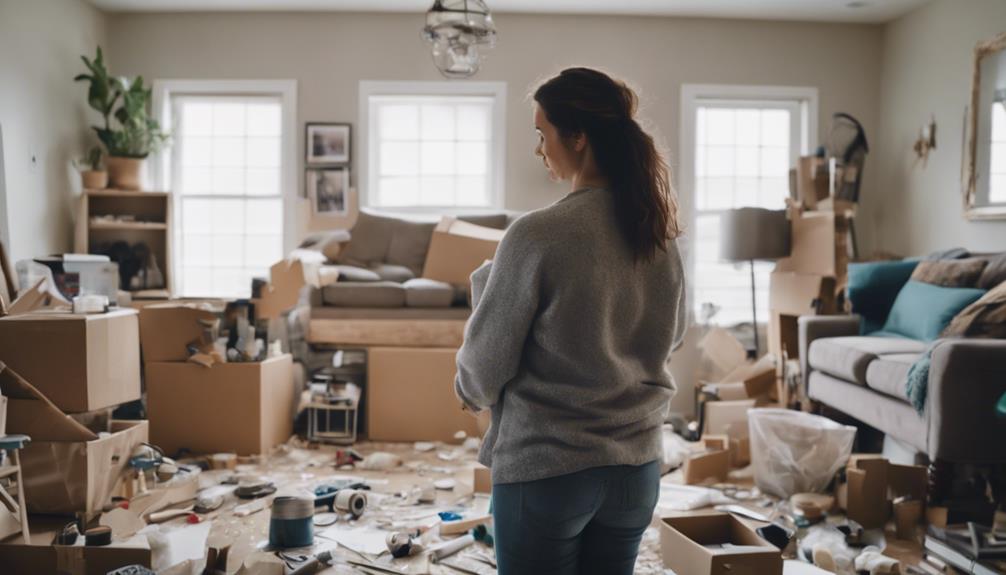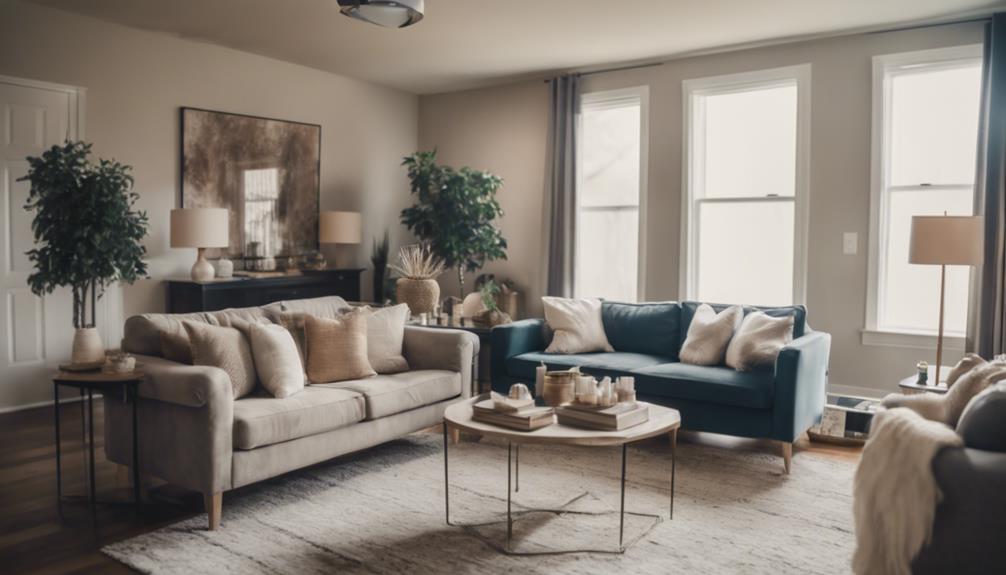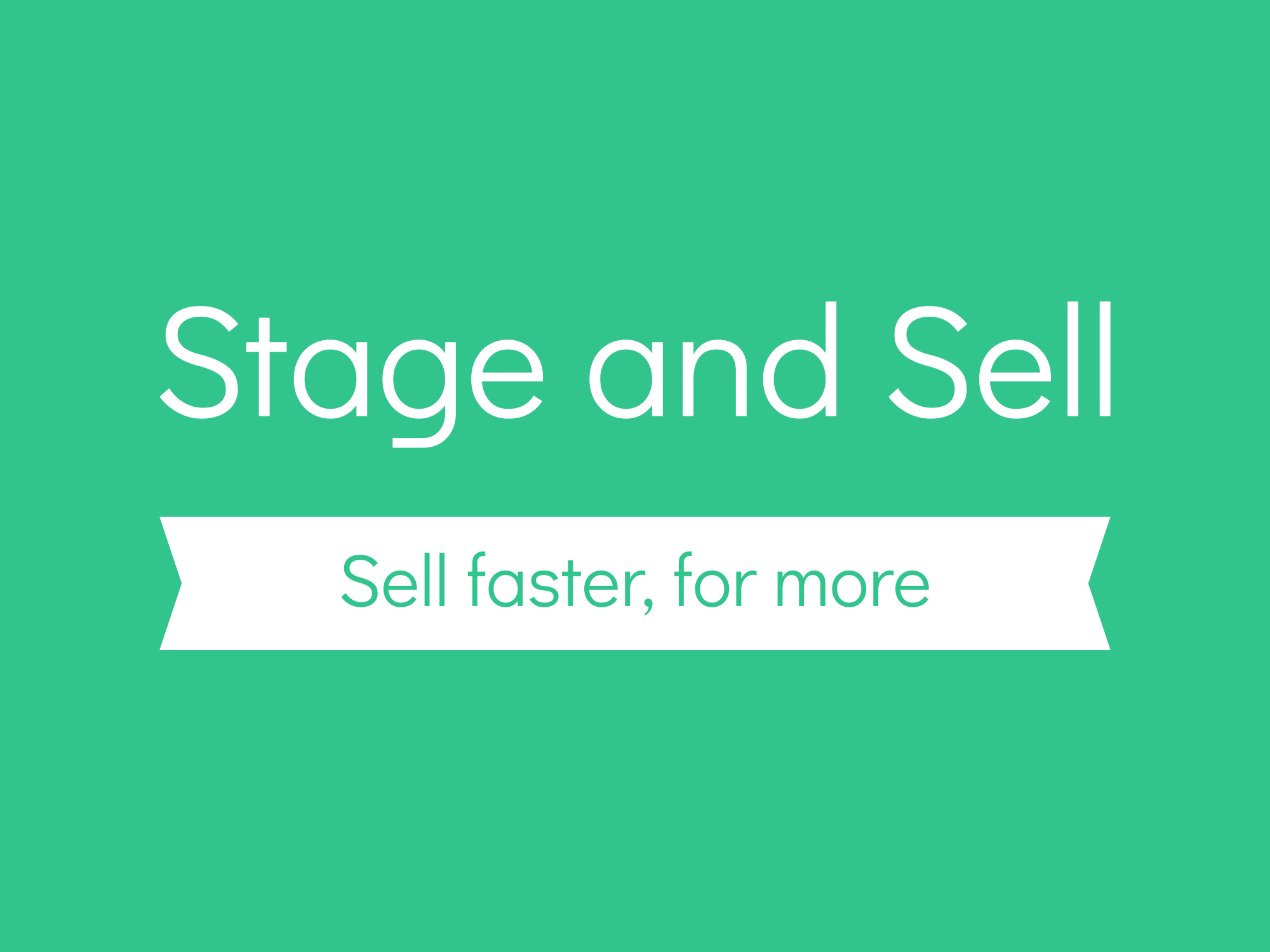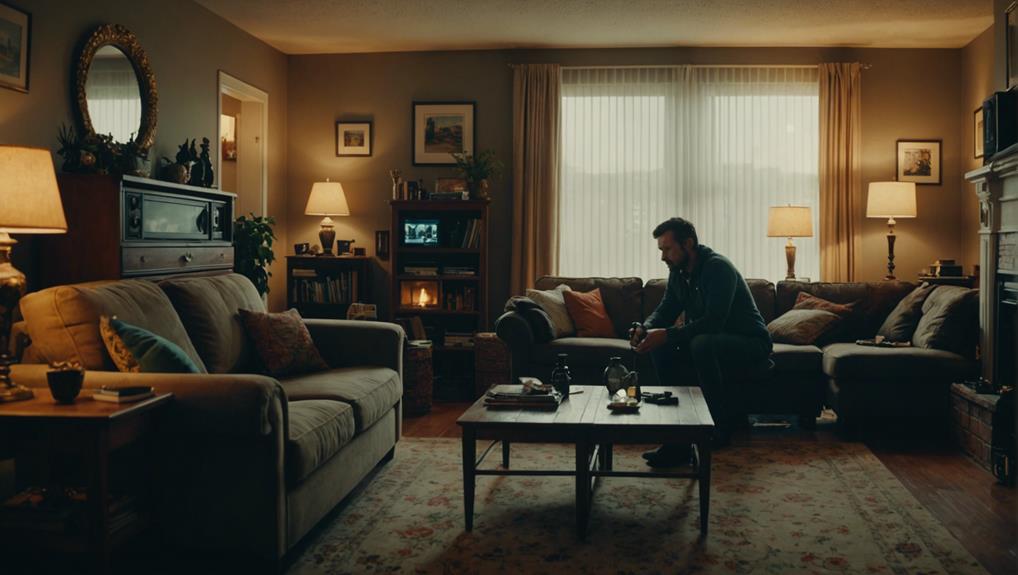When staging your home on your own to elevate its market value and accelerate the sale process, you can expect to invest between $500 and $2,000. The process typically demands 8-20 hours of your time for organizing, decluttering, and refreshing spaces with new decor and paint.
Thorough cleaning of every corner is crucial. Additional expenses might include professional cleaning services and storage solutions, with simple staging supplies potentially costing between $300 and $500. It's worth noting that well-staged homes can sell for up to 17% more and much quicker than non-staged ones.
However, hiring a professional stager could potentially yield even greater returns. It's essential to consider the balance between the costs, the time commitment, and the prospective increase in sale price. Your effort in staging could significantly enhance your home's appeal and marketability.
Financial and Effort Investment Required
When undertaking DIY home staging, it's crucial to be prepared for both financial and effort investments, which typically range from $500 to $2,000, depending on the size and condition of your property. Effective staging is essential not only to maximize this investment but also to significantly enhance the value of your home and accelerate the selling process.
To boost the efficiency of your DIY staging, start by decluttering and organizing your space to create a more open and inviting atmosphere. Small investments in attractive decor and a fresh coat of paint can dramatically alter the appearance of your home, making it more appealing to potential buyers. Ensure that every area is meticulously cleaned and consider renting off-site storage to declutter and better showcase your property.
Being resourceful in staging involves strategically rearranging furniture to optimize the use of space and accentuate the best features of your home. Diligently planning and implementing these staging tactics can greatly improve your home's presentation, thereby increasing its market value and facilitating a quicker sale at an attractive price.
Time Commitment for DIY Staging
To enhance the value of your home and accelerate its sale, staging is a strategic approach worth considering. It involves a significant time investment, which can range from several hours to multiple days, particularly for larger or more cluttered properties. Typically, homeowners invest about 8-20 hours in staging, depending on their level of experience and the volume of modifications required. This investment of time, while considerable, can greatly influence buyer perceptions and contribute to a quicker sale at a potentially higher price.
Managing this process efficiently is crucial to avoid overwhelming your already busy schedule. Effective time management strategies, such as setting clear objectives for each staging phase, prioritizing tasks, and devising a practical timetable, can help streamline your efforts. By adopting these productivity techniques, you can efficiently transform your home into an attractive and market-ready property, thus enhancing its appeal to prospective buyers and maximizing your return on investment.
Hidden Costs of DIY Staging

When staging a house to enhance its value and accelerate the sale process, it's crucial to anticipate and budget for hidden costs that could impact the overall investment. Here are some key considerations:
- Unexpected Costs: Staging a home yourself might lead to unexpected expenses, such as professional cleaning services or last-minute decor tweaks to appeal to potential buyers.
- Storage Solutions: You may need to rent a storage unit to declutter and depersonalize the space, making it more attractive to buyers by showing them a clean and spacious environment.
- Purchasing Decor: Investing in new decorative items can be necessary to modernize the look of your home and make it more appealing, which might involve additional expenses.
- Transportation Fees: There could be costs associated with transporting furniture and decor to and from your home, especially if you're bringing in special pieces to enhance the staging.
Planning for these hidden expenses is essential for a successful staging that maximizes your home's market value and speeds up the sale. By being well-prepared and strategic, you can ensure a smoother staging process and a quicker, more profitable sale.
DIY Staging Supplies and Expenses
Investing in DIY staging supplies and effectively managing related expenses is crucial for enhancing the value of your home and accelerating its sale. A typical budget for DIY staging resources can range between $300 to $500. This investment covers essential items such as paint, cleaning supplies, and minor repairs which are fundamental in making your property more attractive to potential buyers.
To further maximize your home's appeal and increase its market value, it's advisable to consult with a staging professional, which generally costs between $100 to $300. This expert guidance can be instrumental in highlighting your home's strengths and addressing any weaknesses.
Additionally, to create a compelling and inviting environment, you might consider renting furniture or décor, or purchasing new decorative items. These steps, while potentially adding to your expenses, can significantly boost the aesthetic appeal of your space and make it more enticing to buyers.
By strategically leveraging DIY staging techniques and making judicious use of your resources, you can stage your home efficiently and effectively, thus ensuring a quicker sale and potentially higher selling price. Below is a breakdown of potential expenses you may incur while staging your home:
| Supplies/Expenses | Estimated Cost |
|---|---|
| DIY Staging Supplies | $300 – $500 |
| Professional Staging Consultation | $100 – $300 |
| Renting Furniture/Decor | Additional Cost |
Impact on Selling Price

Enhancing your home's appeal through professional staging can significantly elevate its market value and accelerate the sale process. Here's how effective staging can transform your home's selling dynamics:
- Increased Market Value: Proper staging showcases your home at its best, potentially increasing its market value.
- Quicker Sales Process: Homes that are professionally staged often sell faster, reducing the time your property spends on the market.
- Boosted Perceived Value: Strategically staging key areas of your home can greatly enhance its perceived value to prospective buyers.
- Market Competitiveness: On average, professionally staged homes can sell for up to 17% more than non-staged homes, offering a competitive advantage in the real estate market.
Investing in professional staging, therefore, not only potentially raises your home's selling price but also facilitates a swifter sale, benefiting you both financially and practically.
DIY Staging Vs. Professional Staging Costs
When considering staging a house to increase its value and accelerate the sale process, evaluating the options between DIY staging and hiring a professional becomes crucial. DIY staging might involve an initial outlay of $100 to $1,000 for essential supplies and decorations. On the other hand, professional staging costs can range from $500 to $5,000 or more, based on the extent of services availed.
Although DIY staging appears more economical at first glance, additional costs may arise from renting furniture or decorative elements, which can close the price gap with professional staging. The expertise offered by professional stagers in crafting aesthetically pleasing environments can significantly boost the home's appeal and captivate potential buyers. This enhanced presentation can't only elevate the property's market value but also facilitate a faster sale, making the investment in professional staging worthwhile despite its higher initial expense.
When deciding how to stage your home for the market, it's important to focus on the end goal: maximizing property value and minimizing time on the market. Professional staging, with its strategic design and expert touch, often proves to be the more advantageous choice in achieving these objectives.
DIY Staging Time Vs. Money Saved

When staging a house to enhance its value and accelerate the sale process, it's essential to consider whether DIY staging or hiring a professional stager is the most effective strategy. Here are several factors to evaluate:
- Time Investment: DIY staging demands a significant time commitment, as you'll need to plan, declutter, and decorate your home to make it appealing to potential buyers.
- Impact on Sale Price: While DIY staging can reduce initial costs, it mightn't always present your home in the best light, potentially affecting the offers you receive. Professional staging, although more costly upfront, often results in a higher selling price due to a more polished presentation.
- Speed of Sale: Professional stagers know how to make a home market-ready for a broad audience, which can lead to a faster sale. Their expertise in optimizing the layout and decor can significantly shorten the time your home spends on the market.
- Presentation Quality: The quality of staging can make a substantial difference. Professional stagers bring their expertise in interior design trends and buyer preferences, ensuring that your home appeals to the highest number of potential buyers.
Considering these aspects will help you decide if the investment in professional staging is justified by a quicker sale and a higher sale price, or if DIY staging is a more practical approach for your situation.
DIY Staging Labor Vs. Results Achieved
Given the labor-intensive nature of DIY staging, it's crucial for homeowners to weigh the potential benefits against the labor involved, especially when aiming to increase property value and accelerate sale times.
DIY staging, while cost-effective at first glance, can lead to significant pitfalls and may not always yield the desired results. Mistakes in staging can't only delay the sale but might also necessitate additional investment in correcting these errors.
On the other hand, hiring professional stagers can be a strategic move. These experts possess the skills to enhance the appearance of a home, optimizing the layout and decor to appeal broadly to potential buyers. This professional touch often leads to quicker sales and can significantly boost the property's market value.
While there are instances where DIY staging has been successful, these cases are less common. Homeowners should consider the long-term advantages of professional staging, as it couldn't only expedite the sale but also potentially increase the sale price, making it a worthwhile investment over DIY efforts.
DIY Staging Challenges and Solutions

Transitioning from the discussion on DIY Staging Labor Vs. Results Achieved, it's clear that DIY staging, while cost-effective, comes with its own set of challenges that can affect the overall goal of enhancing a home's value and accelerating its sale. Here we explore the common challenges of DIY staging and propose strategic solutions to maximize property appeal and minimize market time:
- DIY staging errors: Without a deep understanding of design principles and staging techniques, DIY efforts can result in less appealing presentations. This can detract from the home's perceived value and attractiveness to potential buyers.
- Extended market time: DIY staging may not resonate well with buyers, potentially leading to a longer time on the market. This delay can necessitate price reductions, undermining the very purpose of staging to boost value.
- Suboptimal space optimization: Lacking professional insights, homeowners may find it challenging to effectively utilize space, which is critical in showcasing the home's potential and functionality to prospective buyers.
- Advantages of professional staging: Statistics show that professionally staged homes can sell up to 73% faster than non-staged ones, highlighting the significant impact of expert staging on accelerating sale times and potentially increasing the home's market value.
Given these insights, homeowners should carefully consider the challenges of DIY staging and the pronounced benefits of professional staging to ensure they achieve the best possible outcome in enhancing their home's value and expediting its sale.
Evaluating DIY Staging ROI
When preparing a house for sale, staging is a strategic move aimed at enhancing the property's appeal to increase its value and accelerate the sale process. Here's a breakdown to help you understand the benefits of both DIY and professional staging in achieving these goals:
| Aspect | DIY Staging | Professional Staging |
|---|---|---|
| Cost | $500-$2,000 | $2,000-$7,000+ |
| Impact on Value | Up to 5% increase | Often higher increase |
| Speed of Sale | Potentially slower | Generally faster |
| Ongoing Expenses | May increase | Likely to decrease |
| Appeal to Buyers | Somewhat enhanced | Significantly enhanced |
While DIY staging is more budget-friendly, it might not always present the house in the best light due to limited resources and expertise, potentially prolonging the time on the market and increasing holding costs. In contrast, professional staging, though more costly upfront, employs expert techniques to showcase the home's best features, thereby attracting more buyers and contributing to a quicker sale. This can lead to a higher selling price, offsetting the initial investment in professional staging services.
Conclusion
To conclude, when considering DIY home staging, it's crucial to assess not only the financial outlay but also the investment of time, unexpected costs, and the potential enhancement in sale price. Implementing DIY staging can be cost-effective initially, but it demands considerable effort and resources.
The goal of DIY staging is to elevate your home's appeal to sell it faster and possibly for a higher price. Carefully evaluate all factors to decide if DIY staging will effectively meet your goals in the real estate market.

